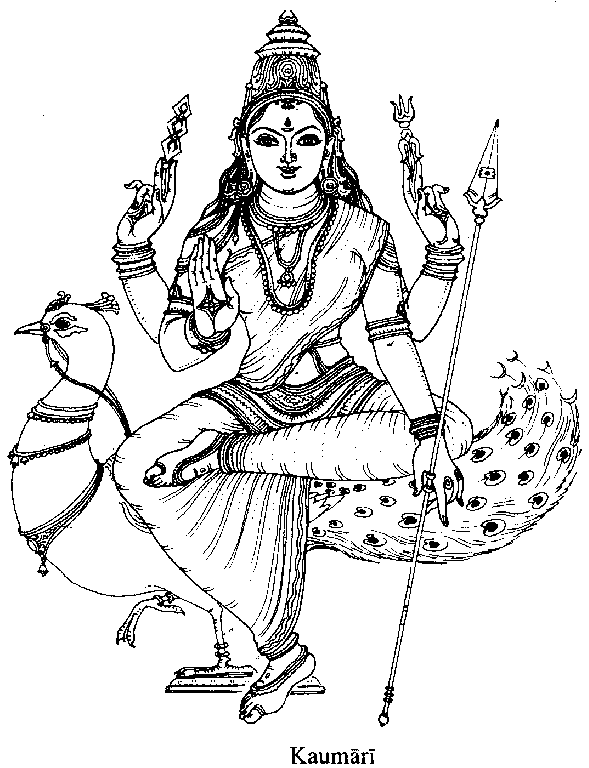
|
||
|
| ||
The Iconography of Goddess Kaumārī or Kanyā Kumārī
According to the Matsya Purāna1 the Kaumārī image should have peacock as the vahana; she should be clad in the red cloth and must have śakti and śūla as her weapons. Kumārarūpā
Kaumarī mayūravaravāhanā | The Devi Purāna3 describes Kaumārī thus: Kumārarūpadhāri ca Kumāra-jananī tathā | In the well-known Taittirīya Aranyaka (10th Book) passage Durgā is addressed as Kanyā Kumārī.4 She was regarded as a member of the family of ‘seven Mothers' all of whom were looked upon as the different aspects of the goddess Śakti or Durgā, the spouse of Mahādeva. In course of time this goddess (Kaumārī) was made Kārttikeya's wife and came also to be known as Kumārī or Kārttikeyāni.5 The name Kumārī instinctively reminds us of the term ‘Kanyā Kumārī' applied to Durgā in the well-known Taittiriya Aranyaka passage, referred to above. There is reason to believe that Kumārī is a shorter form of the term ‘Kanyākumāri' which is both the name of a place (the southernmost point of the Indian peninsula) and that of a goddess. The Matsya Purāna6 describes her as the daughter of Lalitā and mentions Māyipuri as a place sacred to her, Māyāpuryām Kumāri tu santāne Lalitā tathā; she is also mentioned in the Brahmānda, IV.26-73-117 where her military skill has been eulogised. According to this account the goddess Kumārī killed all the sons of the demon Bhanda. Reference to the worship of the goddess Kaumārī or Kumārī at Cape Comorin is found in the famous Periplus7, written by an unknown Greek sailor in the second half of the 1st century A.D. The earliest Kaumārī sculpture goes back to the Gupta period. Her image along with those of other ‘Mothers' is found near Eran.8 Her icon is also to be noticed in the Elephanta Cave (as has been noted above), where she is distinctly called Kārttikeyānī. The goddess here has two arms and she is seen seated upon the peacock. A four-armed Kāumāri image (Fig. 29) was found at Bheraghat (Jabalpur, M.P.). It was assigned to the Kusāna period by R.D. Banerji9 ; the writer in J.A.S.B. (Letters), Vol. XXII. pp. 237 ff., however, places this image in the second half of the 7th century A.D.10 The image is headless with all the hands broken. Another 7th-century Kaumārī sculpture is found in the Gwalior museum; the image is two-armed and has śakti and lotus as the attributes.11 A number of 8th-century sculptures of the ‘seven Mothers' including that of Kaumārī were recovered from the river Vaitarani "where they were tossed by the Mughuls on their shrines being destroyed"12. Plate 1, fig. 4 of the M.A S.L, No. 44 is a huge four-armed image of the goddess Kaumārī (Fig. 30) with a pot-bellied child seated on the left knee. The deity has an unaffected smile on her lips. The goddess is very boldly executed with peacock, carved on the base; much prominence has been given to the two breasts. Plate IX, fig. 1 (ibid) is another Kaumārī image found from Puri (Fig. 31); this image is more sophisticated than the Jajpur icon and is perhaps of somewhat later date. Notes
Sources
From Chatterjee, Asim Kumar. The Cult of Skanda-Karttikeya in Ancient India (Calcutta: Punthi Pustak, 1970) pp. 139-141. Other research articles on Skanda-Murukan |
